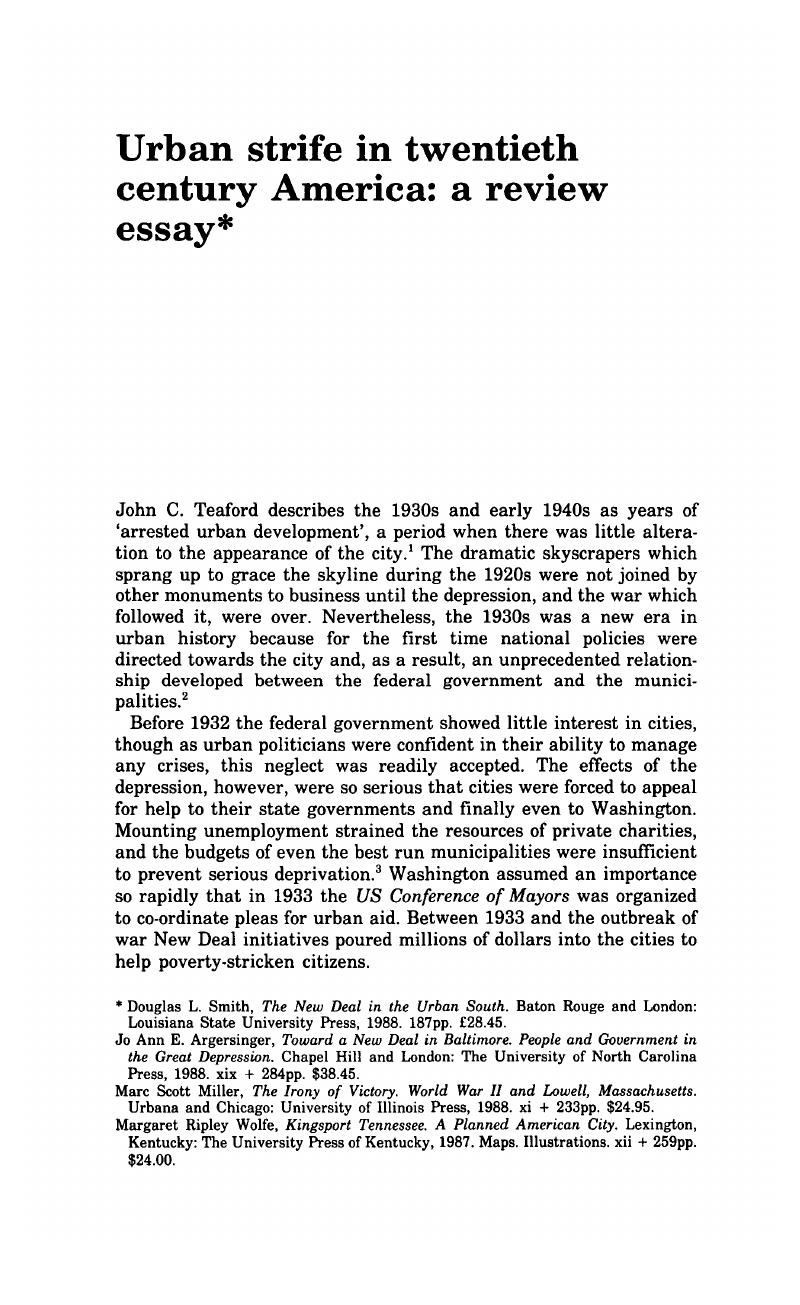No CrossRef data available.
Published online by Cambridge University Press: 09 February 2009

Douglas L. Smith, The New Deal in the Urban South. Baton Rouge and London: Louisiana State University Press, 1988. 187pp. £28.45.
1 Teaford, Jon C., The Twentieth Century American City. Problem, Promise, and Reality (1986), 74–96.Google Scholar
2 Gelfand, Mark I., A Nation of Cities. The Federal Government and Urban America, 1933–1965 (1975), 23–70.Google Scholar
3 For a more thorough coverage: Brown, Josephine C., Public Relief, 1929–39 (1940), 63–142Google Scholar; Freeman, H.H., ‘How American cities are retrenching in time of depression’, National Municipal Review, xxi (04 1932), 267–81CrossRefGoogle Scholar; Heleniak, R., ‘Local reaction to the great depression in New Orleans’, Louisiana History (Fall 1969), 289–306Google Scholar; Steinsher, B. (ed.), Hitting Home, The Great Depression in Town and Country (1970).Google Scholar
4 For the New Deal era: Badger, Anthony J., The New Deal. The Depression Years, 1933–1940 (1989)CrossRefGoogle Scholar; Fearon, Peter, War, Prosperity and Depression. The U.S. Economy 1917–1945 (1987).Google Scholar For the Second World War: Blum, John M., V was for Victory (1976)Google Scholar; Perrett, G., Days of Sadness, Years of Triumph. The American People 1939–1945 (1973)Google Scholar; Polenberg, R., America at War. The Home Front, 1941–1945 (1972).Google Scholar
5 Wallis, J.J., ‘Employment and the great depression: new data and hypothesis’, Explorations in Economic History, 26 (1989), 45–72CrossRefGoogle Scholar; Mendershausen, H., Changes in Income Distribution during the Great Depression (1946), 12–22.Google Scholar
6 Cobb, James C., Industrialisation and Southern Society 1877–1984, 36.Google Scholar
7 Jackson, K.T., The Ku Klux Klan in the City, 1915–1930 (1967).Google Scholar
8 Tindall, George B., The Emergence of the New South, 1913–1945 (1967), 490–1.Google Scholar
9 Final Statistical Report of the FERA (1942), 6–7.Google Scholar
10 Reading, Don C., ‘New Deal activity and the States, 1933–39’, Journal of Economic History, 33 (1973), 792–807.CrossRefGoogle Scholar
11 Wright, Gavin, ‘The political economy of New Deal spending. An econometric analysis’, Review of Economics and Statistics, 56 (02 1974).Google Scholar
12 Brownell, B.A., ‘The urban south comes of age, 1700–1940’ in The City in Southern History. The Growth of Urban Civilisation in the South, (eds) Brownell, B.A. and Goldfield, D.R. (1977).Google Scholar
13 Wolters, Raymond, Negroes and the Great Depression. The Problem of Economic Recovery (1970), 203–6.Google Scholar
14 Wilson, W.H., Coming of Age. Urban America, 1915–1945 (1974), 184–8.Google Scholar
15 Brock, William R., Welfare Democracy and the New Deal (1988), 154.CrossRefGoogle Scholar
16 Perhaps the most interesting question is not what did the New Deal do to the cities, but what did the cities do to the New Deal? For an interesting view on a large northern metropolis see Trout, Charles H., Boston, The Great Depression and the New Deal (1977).Google Scholar
17 Unlike the drama recorded in Carr, L.J. and Sterner, J.E., Willow Run. A study of Industrialisation and Cultural Inadequacy (1952)Google Scholar, the best state study is Clive, Alan, State of War: Michigan in World War II (1979).Google Scholar
18 Especially the regional analyses offered by Nash, Gerald D., The American West Transformed: The Impact of the Second World War (1985)Google Scholar; Wright, Gavin, Old South, New South. Revolutions in the Southern Economy since the Civil War (1986).Google Scholar
19 An interesting study on planning history is: Boyer, M. Christine, Dreaming the National City. The Myth of American City Planning (1983).Google Scholar
20 Other excellent examples include: Buder, Stanley, Pullman: An Experiment in Industrial Order and Community Planning, 1880–1930 (1967)Google Scholar; Mohl, Raymond A. and Betten, Neil, Steel City: Urban and Ethnic Patterns in Gary, Indiana, 1906–1950 (1986)Google Scholar; Garner, John S., The Model Company Town: Urban Design Through Private Enterprise in Nineteenth Century New England (1984).Google Scholar